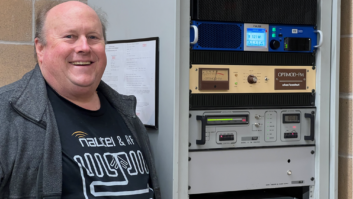Despite the attention of the FCC on everything broadband, some radio items were accomplished in calendar year 2012.
Hands down, the most notable decision affecting radio concerned the balancing of the needs of those who want to own low-power FM stations as well as broadcasters waiting to hear how the agency will treat the more than 6,500 pending FM translator applications.
In adopting more rules to expand the LPFM service, the agency relaxed the criteria for LPFMs seeking a waiver for the second-channel spacing requirement in order to locate a new LPFM. The agency also detailed how it will process pending FM translator applications.
In June, third-adjacent channel spacing protections for full-service FMs went away though channel protections remain in place for radio reading service stations. The change was part of the agency’s implementation of the Local Community Radio Act.
Federal wildlife researchers believe migratory birds become disoriented by steady red warning lights on communications towers. This year, the Federal Aviation Administration decided it’s okay to turn those off because pilots can still see the towers with the flashing red warning lights. Broadcasters who want to do this face a two-step process with the FAA and the FCC.
The commission now requires formal notice before construction of new towers taller than 450 feet, with an environmental assessment of the potential impact on migratory birds.
AMs won expanded access to FM translators. In 2009, the commission began allowing AM signals to be carried on FM translators; but until this year, only translators authorized before May 2009 could be used.
Last spring, the commission decided that any translator ultimately approved from the backlog of some 6,500 pending applications can be used to retransmit AM signals. Proponents said it expanded opportunities for AMs while opponents worried about limiting avenues for new LPFMs.
EAS planners were still considering next steps for the alerting technology, though the Commercial Mobile Alert System, consisting of wireless text alerts, launched. After the national EAS test in fall 2011, the FCC asked broadcasters to send in their results; by spring of 2012, officials said they were still awaiting some results but gave no word on if any of that data would be publicly released since they had initially promised broadcasters anonymity.
By June 30, broadcasters were supposed to have Common Alerting Protocol-compliant EAS equipment in place.
The Janet Jackson wardrobe malfunction case came to the end of the road in June when the Supreme Court declined to review a lower court ruling that overturned the FCC’s $550,000 fine against CBS Corp. for televising a fleeting view of Jackson’s breast during the live 2004 Super Bowl half-time show. The case was notable because it led to more profanity delay equipment installations for both radio and television stations.
In a related note, the Supreme Court in June tossed out indecency fines against Fox and ABC on narrow procedural grounds, telling the agency it’s free to update its broadcast indecency guidelines.
The makeup of the agency itself changed with the addition of two more commissioners. Commissioner Jessica Rosenworcel came to the FCC in May. The Democrat was most recently a staffer on the Senate Commerce Committee.
Ajit Pai returned to the agency in May, but now as a commissioner; the Republican had previously held several positions in the general counsel’s office at the commission between 2007 and 2011. Most recently, Pai was a partner at Jenner & Block.












